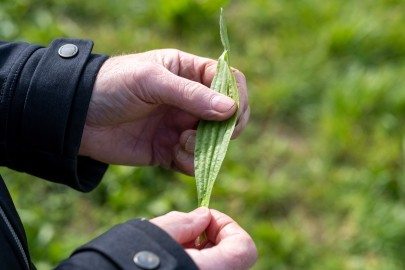Searching for optimal grazing systems continues to be a major motivation for researchers focused on finding ways to mitigate nitrous oxide (N₂O) emissions to help combat climate change.
In the agricultural sector, understanding the impact of different feed crops is key when it comes to making decisions about pasture management and reducing greenhouse gas emissions.
Recent findings from a study led by Massey University New Zealand Agricultural Greenhouse Gas Research Centre scholarship student Chi Vi, who was co-supervised by Manaaki Whenua researcher Dr Surinder Saggar, have shown that adding plantain (Plantago lanceolata) to mixed pastures with perennial ryegrass and white clover in dairy-grazed pastures has several benefits. Surinder says plantain is known for its ability to improve the productivity of summer feed and reduce N₂O emissions.
This was a complex research project that ran over 2 years and involved the capture of urine from cows grazing swards with different plantain compositions.
Plantain works in two ways, one in the animal and one in the soil. In the first effect in the animal, not only is more of the nitrogen from the plant excreted in dung than urine, but plantain also has a higher moisture content than other grazing plants and a diuretic effect. This makes the cows urinate more frequently, creating more urine spots, but they are much less concentrated.
The second effect is in the soil where the chemicals in the plantain and plantain roots slow the rate at which the urine breaks down to nitrate, which allows more time for the nitrate to be taken up by plants. This contributes to improving pasture production, particularly during dry periods in the summer when feed availability is typically low.
“The challenge,” says Surinder, “has always been knowing how much plantain should be included with perennial ryegrass and white clover in mixed pastures to maintain consistent productivity and how to measure the reduction in N₂O emissions.” He adds the loss of plantain plants in ryegrass/clover pastures is inevitable with time, so broadcasting fresh seed at the end of each growing season is needed to maintain a sufficient proportion of plantain in mixed pasture.
The results of the study, published in the journal Agronomy, showed pastures with a mixed pasture containing between 50% and 70% plantain content were the most efficient at creating a stable pasture system and improving feed productivity, while reducing N₂O emissions from cow urine patches. Surinder says this information can be useful for farmers and policymakers in making decisions about pasture management that will contribute to reducing greenhouse gas emissions from agriculture.
Research publication:
Source: Manaaki Whenua Landcare Research












